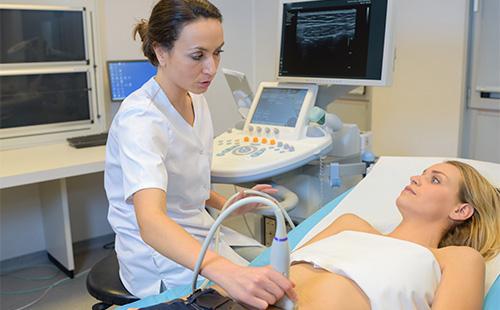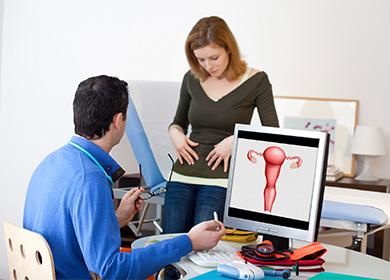The content of the article
Gynecologists have no questions whatsoever in connection with the formation of ovarian cysts in patients - and whether there are bilateral cysts, and what to do if they form constantly, and how they are treated and even cystic prolapse can occur. And even if they may seem strange to someone - if such questions are asked, then they really care about someone, after all, patients are not doctors, if they knew the answers to their questions, they would not ask. Therefore, let's understand what it is - an ovarian cyst and what to do with it.
The cysts that form in the ovaries of women can be divided into functional, appearing as a result of transient disorders, and permanent. The latter arise against the background endometriosis, intrauterine developmental pathology (dermoid). To confirm their nature often succeeds only after removal and histological examination. But even behind a seemingly innocuous cyst, cancer can hide.
What are
The ICD-10 cyst of the left or right ovary is a non-inflammatory disease of the uterine appendages and is encrypted with the N83 code. It is necessary to judge the nature of formations based on the clinical picture and observations of such tumors in dynamics.
Functional Education
Often they are referred to as tumor formations and are called retention ovarian cysts. This category includes the following.
- Cyst of the corpus luteum.After ovulation, a yellow body forms at the site of the follicle. Its main task is the synthesis of progesterone. Sometimes a cyst may form in this place. This is especially often observed during pregnancy. Normally, the corpus luteum cyst of the ovary (theca-luteal) should pass on its own within two to three months or until 16-18 weeks of pregnancy. Otherwise, it is better to delete it.
- Follicular. In the first phase of the menstrual cycle, the follicle grows and ripens, which should ovulate. For a combination of reasons, this does not happen, for example, with hormonal failure or inflammation. In this case, the follicle continues to grow and sometimes reaches sizes up to 10 cm or more. In 95% of cases, such cysts pass independently within two to three cycles and do not cause particular concern to a woman. With a complicated course, they can rupture, become inflamed, and even turn into malignant. Follicular cysts are most often found in girls during the formation of menstrual function and in women in premenopause. Hormonal disorder disrupts the ovulation process, which entails similar functional formations.
Congenital
With these cysts, women are born, but for a long time, education can remain undiagnosed. At some point, they begin to grow and are easily determined upon examination. Such cysts include, for example, dermoid cysts. They are formed from embryonic rudiments in the tissues of the ovaries.Against the background of stresses, experiences, transferred experiences or diseases, they increase in size.
Acquired benign tumors
Cysts are single-chamber or multi-chamber. The latter has a less favorable course - they often do not respond to conservative treatment, have medium and large sizes, and papillary growths with cancer cells may be hidden on the partitions.
- Endometriotic ovarian cysts. Initially, foci of endometriosis on the appendages are formed. Over time, they accumulate "chocolate content" - coagulated blood and cellular elements, for this reason, the cyst increases in size. Often, such formations are found in both ovaries. Endometriosis is a systemic disease, and endometriotic cysts are one of its manifestations. Therefore, the treatment of such formations is not only surgical removal, but also subsequent long-term hormonal therapy.
- Cyst is paraovarial. These are the most harmless formations, localized between the leaves of the wide ligament of the uterus in the gap between the fallopian tubes and the uterus itself. Most often they are small in size, do not require removal. It is believed that the laying of such cysts is still in utero, since paraovarial formations are found even in young girls.
- Cystadenomas. These are ovarian cysts, by their signs, are similar to functional formations, but do not pass on their own. Three types of cystadenomas are distinguished depending on the contents: serous cysts (inside the liquid is often straw or transparent), mucinous (if the contents are mucus) and papillary (if there are papillary growths inside). The latter pose the greatest danger, since cancer can “hide” in them.
Who are more likely to form
Cyst-like formations and ovarian tumors are most often formed in girls during the formation of menstrual function - 12-16 years old, as well as in women during the period of perimenopause. This is due to serious hormonal fluctuations and an unstable background of estrogens and gestagens. The following women are also at risk.
- With hormonal disorders. Anovulatory cycles and bleeding, irregular periods, an increase in the level of male sex hormones - all this increases the likelihood of cyst formation on the ovaries, most often of a functional nature.
- With metabolic syndrome. Women with overweight, high blood pressure and diabetes increase the risk of not only benign ovarian tumors, but also malignant.
- With chronic inflammation. Sluggish appendage infections increase the likelihood of changes in the metabolism and growth of ovarian cells, stimulating abnormal processes in them.
- Smoking girls. Smoking does not increase ovarian cancer, but women who regularly inhale nicotine and tobacco smoke are more likely to have functional ovarian cysts.
- Nulliparous ladies. Late first birth (after 35 years) or their absence also negatively affects ovarian function.
- After IVF or stimulation. In vitro fertilization protocols include the use of large doses of hormonal drugs. So the growth of several follicles is pumped up.But such schemes stimulate the growth of other cells, increasing the level of mutations in them and, as a result, degeneration. It is believed that three IVF attempts increase the risk of cysts in women by 10 times.
- After removal of the ovary or uterus. Cysts often form a year or more after removal of the uterus (for example, about fibroids) or with one ovary removed. This is a kind of compensatory transformation and the result of hormonal changes in the body. Sometimes such cysts become large, over time they can also become malignant, and therefore require observation and treatment. Sometimes they resort to their puncture if the doctor is confident in their benign nature.
The main symptoms of ovarian cysts
The asymptomatic course of ovarian cysts is characteristic of uncomplicated and small formations. Most often, a woman is still worried about something.
Pain
This is the most common symptom. The larger the neoplasm in the ovaries, the more distinctly the woman will celebrate it. The pain can be localized on the right or left lower abdomen, there may be a pressing sensation on the rectum. Often a woman notes recent discomfort during sex, while the pain appears in certain positions of the body (depending on the location of the cyst), most often in the middle of the cycle or on the eve of menstruation (especially with endometrioid ovarian cysts).
Other symptoms
In addition to pain, the following symptoms are characteristic:
- menstrual dysfunction - delays, heavy discharge;
- hyperandrogenism - male-type hair growth (along the white line of the abdomen, inner thighs);
- conception problems - ovarian cysts can “close” the vicious circle of disorders and stimulate problems with ovulation;
- pressure on neighboring organs - with medium and large sizes of cysts, frequent urination and a tendency to constipation may occur.

How to identify ailment
You can suspect a woman's ovarian pathology during a gynecological examination. On palpation in the area of the appendages, formations of various shapes and consistencies are determined. But for confirmation, an additional examination is necessary. It includes the following.
- Pelvic ultrasound. Qualitatively and correctly performed ultrasound examination helps to identify formations on the ovaries even of small sizes. Using ultrasound, you can determine the blood flow in the cyst, the number of chambers, contents, the presence of partitions and growths on them. In emergency situations, the study helps to identify indications for surgery. Ultrasound is the most accessible and informative diagnosis of ovarian diseases.
- MRI of the pelvis. It is performed much less often, more often with suspected cancer or in some difficult cases. MRI allows you to get a complete picture of the anatomy and topography (location) of internal organs in the pelvis.
- Tumor marker assays. The study is based on the fact that with a malignant process in the blood, the level of certain proteins rises, they are called tumor markers. For each tumor, its compounds are informative. For ovaries, CA-125, ROMA, CEA is performed.
- Laparoscopy. To clarify the formations on the ovaries, a diagnostic operation can be performed, the purpose of which is to identify the pathology and determine the treatment tactics. Often during laparoscopy, simultaneous removal of cysts is performed.
If surgical treatment of a cyst that remains after conservative treatment is planned, an additional examination is performed to exclude malignant growth. This is due to the fact that even, at first glance, benign formations can be cancer or metastases, most often associated with the stomach, intestines and lungs. Therefore, these organs are examined most thoroughly. The following studies are being carried out.
- FGDS. This is a study of the esophagus, stomach and duodenum using a flexible “cord” -manipulator.
- Colonoscopy Examination of the large intestine with a probe similar to the one used in HDF, but it is inserted into the rectum and then moves forward. Instead of a colonoscopy, a sigmoidoscopy can be performed (examination only to the descending colon) or irrigoscopy. In the latter case, a solution of barium suspension is drunk or injected with an enema into the intestine, and the state of the walls and function are evaluated by a series of radiological images.
- Roentgenography. Such a lung examination (can be replaced by fluorography) helps to exclude metastases in this organ in case of ovarian cancer.

Possible complications
Even a benign cyst can have a complicated course. Of the most common, the following are distinguished:
- capsule rupture and abdominal bleeding;
- torsion of the legs and necrosis of the cyst;
- inflammation and abscess;
- can develop into cancer.
Break
Even if the cyst is functional and small, it can rupture without objective reasons, not to mention large tumors, which are much easier to injure. The condition requires immediate surgical treatment, as the process is accompanied by intra-abdominal bleeding. Most often, cyst rupture occurs for the following reasons:
- after physical labor, including after sex;
- in case of inflammation and thinning of the walls;
- if the tumor breaks up during its malignancy (transition to cancer).
During damage to the capsule of the cyst, a woman notes acute pain in the lower abdomen, after which a slight lull is observed. Then the pains increase, there is a feeling of pressure on the rectum. Nausea, vomiting, decreased pressure, increased heart rate and even loss of consciousness with massive blood loss join in.
Torsion legs
If, for some reason, torsion of the legs of the ovarian tumor occurs, subsequently necrosis (tissue necrosis) develops in this place and peritonitis. Tumor leg - all vessels, nerve and lymph ends, ligaments that fit the ovary. If the torsion occurs at 360 ° C, the clinical picture develops instantly, if less - more slowly. In the latter case, the diagnosis is difficult due to blurred symptoms, so incomplete torsion occurs with more serious complications.
Symptoms of this pathology are as follows:
- drawing pains in the lower abdomen;
- temperature rise;
- nausea, vomiting;
- upon examination - signs of an “acute” abdomen.
Inflammation
In the presence of genital infections, chronic inflammatory processes in the pelvic area, the probability of generalization of the process and the involvement of a cyst is high. It can be either a mild inflammation or an abscess. Depending on the severity of the changes, management tactics come from conservative antibacterial to removal of appendages even with the uterus.
The main symptoms of inflammation of the cyst are as follows:
- pain in the lower abdomen;
- pressure on the rectum may occur;
- high temperature up to 39-40 ° С;
- signs of "acute abdomen" in the formation of abscess and peritonitis.
Pregnancy compatibility
Getting pregnant with an ovarian cyst can be just as likely as without it.
Often, cystic formations on the ovaries in women are found only during pregnancy with screening ultrasound. In 85% of cases, these are corpus luteum cysts that pass on their own until 16-18 weeks and do not pose any danger.
Therefore, the tactics of maintaining ovarian formations during gestation are as follows:
- upon identification - examination for tumor markers;
- pelvic ultrasound monitoring at 16-18 weeks - while maintaining cysts, they are surgically removed up to 20 weeks.
How to give birth with such a pathology
Childbirth can occur naturally even if there is a cyst on the ovary. But the larger its size, the higher the likelihood of complications, for example, a gap. Therefore, caesarean section is often performed with simultaneous removal of the cyst.
How to understand when cancer develops
Often, only after removal of the cyst and its histological examination, it is possible to find out that the tumor has signs of a malignant process. The following series of signs, even before the operation, should prompt this thought:
- too large cysts (more than 10 cm);
- with active blood flow inside according to the results of ultrasound;
- with growths on the walls and partitions by ultrasound;
- if at the same time fluid is found in the pelvis;
- if tumor markers are elevated;
- if there are other signs of an oncological process (e.g. weakness, lethargy, anemia).
But even a small cyst without signs of an active process inside can hide cancer within itself. Clinical cases and reviews of doctors prove this. Therefore, a woman should regularly visit a doctor, follow all recommendations and undergo treatment.

Treatment
To all formations on the ovaries, management tactics have been developed. First, conservative treatment is performed, and then tactics are determined by the results of the control pelvic ultrasound. Possible options are described in the table.
Table - Management tactics for women of different ages with ovarian cysts after drug treatment
| Criteria | Before menopause | In menopause |
|---|---|---|
| Up to 3 cm | - Monitoring and control of ultrasound and tumor markers once a year | - Follow-up with ultrasound and tumor markers every 6 months |
| More than 3 cm | - Up to 6 cm - observation; - more than 6 cm - quick removal | - Surgical removal |
| With signs of inflammation | - Antibacterial therapy; - further management depends on the size and clinical presentation |
|
| With signs of malignant growth | - Removal in the conditions of an urgent histological examination (most often in an oncology hospital) | |
| With an "acute abdomen" | - Immediate surgery | |
Medication
Without surgery, it is possible to cope with most functional entities. Treatment of ovarian cysts in women is carried out for 10-14 days, after which ultrasound is monitored through one menstrual cycle. The following groups of drugs are included in complex treatment.
- Antibacterial. They are always prescribed in the presence of a cyst in order to exclude the inflammatory factor of its formation and avoid complications.The drugs used are cefazolinic (Cefepim, Cefazolin, Cefatoxime), cephalosporin (Zinnat), tetracycline (Doxycycline), a number of penicillins (Ampicillin, Amoxicillin), macrolides ("Azithromycin", Erythromycin", "Vilprafen").
- Anti-inflammatory. They are used to relieve pain and reduce inflammation. It can be rectal suppositories ("Diclofenac", "Indomethacin"), Tablet forms (" Ibuprofen ","Analgin") Or injectable (" Ketonov "," Diclofenac ").
- Vitamins If functional cysts are suspected, vitamins A, E, and C are prescribed to normalize menstrual function and hormonal activity.
- Hormonal After removing active inflammation (if any), treatment is supplemented with hormonal birth control pills. Due to a decrease in ovarian activity, all cystic formations of a functional nature regress. Hormone therapy is prescribed up to three to six months.
- Enzymatic. This group of drugs helps cysts to resolve and prevents the formation of adhesions. Wobenzym,Longidaza».
Combinations of drugs and the duration of treatment can only be determined by a doctor, taking into account a comprehensive examination and the clinical picture.

Surgical
Cysts with hemorrhage, rupture, abscess are subject to urgent removal. Depending on the size of the cyst and the prevalence of the pathological process, the following elements may be removed.
- Only a cyst. With its small size and not involving other structures, the formation is husked, and the bed is sutured with a special seam. This is the least traumatic operation.
- Cyst and part of the ovary. In some situations, it is necessary to remove part of the ovary together with the cyst, for example, if there are polycystic changes in the latter or the cyst cannot be pulled out.
- The entire ovary and cyst. With large sizes, the ovarian cyst practically does not remain - there are no elements that could be preserved. Therefore, in such cases, the appendages are completely removed from one or both sides.
- Appendages and uterus. When abscesses form (often on both sides) or other structures are involved in the pathological process (fallopian tubes, ligaments, and even the uterus), doctors are forced to remove not only the ovaries, but also other parts of the reproductive system.
Laparoscopy of an ovarian cyst may be performed. This is the most preferred method. It is accompanied by minor blood loss, less trauma and small cuts on the skin. But sometimes classic techniques are used with the removal of cysts "by the hands of a surgeon."
Is it possible to avoid an ailment?
Given that the causes of ovarian cysts in many cases are hormonal disorders and inflammatory processes, prevention includes the following:
- reduction in the number of abortions;
- normalization of body weight;
- sufficient physical activity;
- condom protection;
- reasonable use of eco-technologies.
Ovarian cysts are the most common tumor formation on this organ. They can have a benign and malignant course. Follicular cyst is one of the varieties that, in most cases, disappears after conservative treatment. But sometimes ovarian formations are subject to surgical removal. In addition, cysts can be metastases, for example, with gastric cancer in the last stages, they can appear on the left ovary. Therefore, all tumors must be treated with caution and undergo a full examination to establish an accurate diagnosis.

